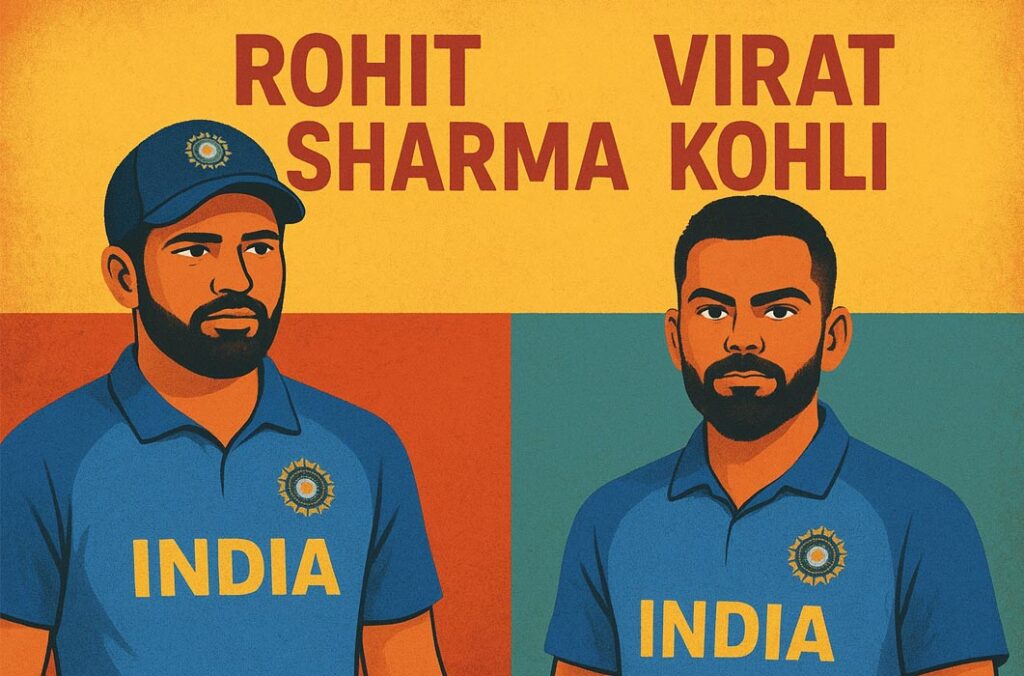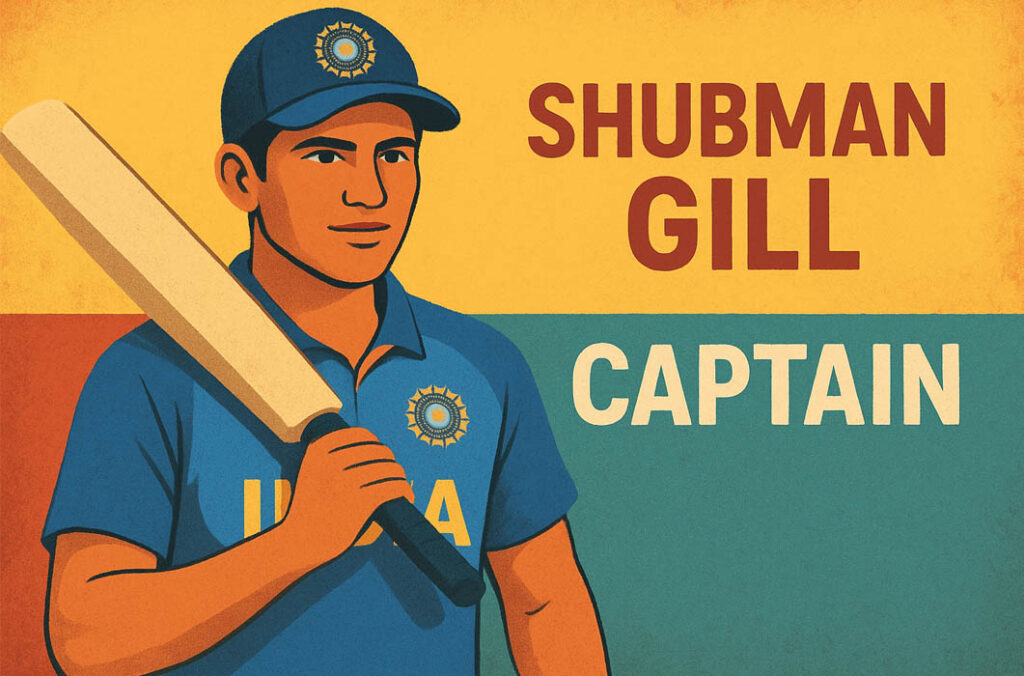Shubman Gill has officially been named India’s new ODI captain for the upcoming series against Australia, with Shreyas Iyer stepping in as vice-captain. Senior stars Rohit Sharma and Virat Kohli remain in the squad, ensuring a strong blend of youth and experience. The tour kicks off on October 19 in Perth with a three-match ODI series, followed by five T20Is across Australia (Reuters).
This leadership shift marks more than just a short-term call — it signals the start of India’s transition towards the 2027 World Cup cycle, balancing veteran presence with a new captain at the helm. In this article, we’ll break down the squad details, reasons behind the change, Gill’s leadership profile, and what to expect in the Australia series.
Shubman Gill – captain profile & how his leadership might look
Shubman Gill arrives as India’s ODI captain with a reputation for calmness under pressure and a bat-first, lead-by-example temperament. He’s not the loud, in-your-face type of leader; instead, his presence is quiet and steady — the kind that settles a dressing room simply by being composed. That temperament has become one of his most valuable assets: when things go wrong, Gill’s instinct is to assess and steady rather than overreact, and that steadiness often rubs off on teammates. Reuters
On the field, Gill has shown technical solidity and a preference for building innings rather than swinging for instant aggression. He reads conditions well and adapts his game accordingly, which is why the selectors clearly trust him to marshal the middle order and set batting targets sensibly. As a batsman-captain he’s likely to lead with batting plans first — expect him to be heavily involved in setting match-ups, rotating strike, and trusting the power-hitters only when the situation is right. ESPN Cricinfo+1
Tactically, there are a few tendencies to watch when Gill is in charge. First, he leans on a calm field placings approach: conservative in the powerplay if early wickets fall, more aggressive in the middle overs to squeeze the scoring rate. Second, he’s shown a willingness to back specialist spinners in middle overs and use them to force mistakes rather than chase wickets with short-term fireworks. Third, expect batting-order flexibility — Gill has already demonstrated openness to shuffle the middle order in response to match situations, which gives the team useful tactical fluidity. These tendencies mean matches under his captaincy could be lower-risk, process-focused affairs rather than all-out gamble-driven games. Reuters+1
Leadership qualities that matter beyond tactics: Gill’s communication style is short and precise. He doesn’t grandstand in press conferences; instead he uses succinct messages to set expectations and protect young players. That kind of leadership can be especially helpful on tough away tours like Australia — it creates clarity without creating noise. Also, his IPL captaincy and recent Test captaincy stints show he can manage dressing-room egos while keeping the game-plan simple. ESPN Cricinfo+1
What the BCCI Announced
Indian Squads for Australia Tour (ODIs & T20Is)
From the official BCCI release:
- ODI Squad: Shubman Gill (c), Rohit Sharma, Virat Kohli, Shreyas Iyer (vc), Axar Patel, KL Rahul (wk), Nitish Kumar Reddy, Washington Sundar, Kuldeep Yadav, Harshit Rana, Mohammed Siraj, Arshdeep Singh, Prasidh Krishna, Dhruv Jurel (wk), Yashasvi Jaiswal
- T20I Squad: Suryakumar Yadav (c), Abhishek Sharma, Shubman Gill (vc), Tilak Varma, Nitish Kumar Reddy, Shivam Dube, Axar Patel, Jitesh Sharma (wk), Varun Chakaravarthy, Jasprit Bumrah, Arshdeep Singh, Kuldeep Yadav, Harshit Rana, Sanju Samson (wk), Rinku Singh, Washington Sundar
These lists show a blend of experience and youth, and signal the selectors’ intent to manage transitions carefully.
Captaincy & Leadership Changes
- Shubman Gill has been appointed as India’s ODI captain, replacing Rohit Sharma.
- Shreyas Iyer has been named ODI vice-captain, becoming the immediate deputy in the 50-over format.
- Rohit Sharma, though stripped of captaincy, is retained in the ODI squad as a senior batter. Similarly, Virat Kohli is part of the ODI lineup.
This change marks a clear pivot in India’s limited-overs leadership design.
Tour Schedule, Venues & Key Dates
- The three-match ODI series begins on October 19 in Perth.
- Subsequent ODIs will be held on October 23 and October 25 (venues include Adelaide and possibly Sydney / Melbourne)
- After the ODIs, five T20Is will follow, starting around October 29 in Canberra and other venues.
So the full tour encompasses both formats, enabling continuity and flexibility.
Why the Change: Selectors’ Reasoning & Context
When the selectors decided to hand over the ODI captaincy to Shubman Gill, it wasn’t just about one series in Australia — it was about the bigger picture. Indian cricket is entering a new cycle, and with the next 50-over World Cup still a couple of years away, this was the right time to identify and invest in a younger leader. Gill, at 26, has already shown he has the temperament to handle responsibility at the highest level, and giving him the reins now ensures he’ll have enough time to grow into the role before the next major ICC event.
Another factor is workload management. Rohit Sharma has carried the burden of captaincy across formats for years, and at this stage of his career, the selectors are keen to let him focus purely on batting. By keeping both Rohit and Virat Kohli in the ODI squad as senior players, the team doesn’t lose out on their experience, but at the same time it reduces the leadership strain on them. This way, India gets the best of both worlds — a fresh captain leading the group, and two of the most seasoned campaigners providing stability and mentorship.
What also stood out during the announcement was the emphasis on building leadership depth. With Shreyas Iyer appointed as vice-captain, there’s clearly a conscious effort to create a strong leadership group rather than depending on just one man. It reflects a shift in mindset: the team is preparing for continuity, ensuring that if Gill is unavailable, there’s another capable leader ready to step up.
As chief selector Ajit Agarkar explained during the unveiling, the move is about planning ahead and giving young leaders enough space to establish their authority. His words carried a simple but powerful message: “We want to give Shubman the time and confidence to grow into the role. With seniors around him, he’ll have the freedom to lead without pressure.”
In short, the change isn’t a demotion for Rohit Sharma — it’s a transition plan. It’s about ensuring that when India steps onto the world stage in the coming years, the team isn’t searching for leadership answers at the last minute.
Rohit Sharma & Virat Kohli – Veterans Retained; What This Selection Signals
Even though Rohit Sharma has stepped down as ODI captain, his presence in the squad remains hugely significant. Rohit isn’t just a senior batter; he’s a guiding force in the dressing room. His experience, especially in handling high-pressure situations in Australia, is invaluable for younger players like Shubman Gill and Shreyas Iyer. Rohit’s inclusion sends a clear message: while leadership is being passed to the next generation, the team still respects and relies on the wisdom of its stalwarts.
Virat Kohli’s retention reinforces this balance. Known for his intensity and hunger for runs, Kohli brings both skill and mentorship to the lineup. For Gill and Iyer, having seasoned campaigners alongside provides reassurance — the kind of backing that allows a new captain to experiment tactically without fear of destabilizing the team.
From a batting perspective, Rohit’s presence also adds flexibility. He remains a dependable opener or top-order anchor, capable of pacing the innings according to match conditions. In crunch situations, his ability to finish games or stabilize after early wickets remains critical. Kohli, meanwhile, offers consistency and the potential to accelerate in the middle overs, complementing the younger batsmen’s natural aggression. Together, their continued involvement ensures that India’s batting unit remains deep, adaptable, and battle-tested — a combination that is particularly crucial when touring challenging Australian conditions.
Ultimately, the selection of these veterans alongside a fresh leadership duo signals a thoughtful transition. It’s a blend of stability and evolution: experience guiding youth, with the team gradually steering towards a post-2025 leadership framework while maintaining immediate competitiveness.

Shreyas Iyer as Vice-Captain: Role & Value to the Leadership Group
Shreyas Iyer’s elevation to ODI vice-captain is a deliberate move that reflects both his cricketing maturity and his ability to lead under pressure. Known for his calm temperament, Iyer brings a sense of steadiness to the middle order, which is crucial in tight games where every run counts. Over the years, he has built a reputation for finishing innings, rotating strike efficiently, and reading match situations quickly — qualities that make him a natural deputy for a young captain like Shubman Gill.
Beyond his batting, Iyer’s previous leadership experience in the IPL has been an asset. He’s captained teams in high-stakes scenarios, managed diverse personalities, and made bold tactical decisions on the field. Translating those experiences to international cricket, he can step in seamlessly if Gill needs support or is unavailable, ensuring that the team’s strategic intent remains intact.
Tactically, Iyer adds depth and flexibility. His presence at No. 4 or 5 allows the team to adjust the batting order based on conditions, opposition attack, or match situation. He can anchor innings when early wickets fall or accelerate scoring when a platform is set, giving India multiple options in crucial overs. As a vice-captain, his role is not just about numbers — it’s about judgment, calm guidance, and reinforcing the leadership group’s cohesion.
In short, Iyer complements Gill perfectly: one brings fresh leadership and long-term vision, while the other provides tactical sense, middle-order stability, and a calm, reassuring presence that balances the team in high-pressure moments.
Fan Reactions (Social Listening Snapshot) 💬
The announcement of Shubman Gill as India’s new ODI captain has ignited a wave of reactions across social media platforms, reflecting a blend of optimism, skepticism, and deep loyalty to the veterans.
🔹 Fans Express Disappointment Over Rohit Sharma’s Removal
Many fans have voiced their discontent regarding Rohit Sharma’s removal from the captaincy. A prevalent sentiment among supporters is the perceived disrespect towards a player who has significantly contributed to Indian cricket. One fan remarked, “Just disrespect,” highlighting the emotional response to the leadership change. India Today
🔹 Debate Over Leadership Transition
The decision to appoint Shubman Gill as vice-captain in previous series had already stirred mixed reactions. Some fans viewed it as a bold move for the future, while others felt it undermined the established leadership. A passionate fan commented, “A slap on the face of haters and illogical audiences who were mixing formats,” expressing their support for Gill’s elevation. NDTV Sports
🔹 Pundits Weigh In
Cricket experts have offered varied perspectives on the leadership change. Former Indian cricketer Harbhajan Singh expressed his disappointment, calling the decision “shocking,” and questioned the removal of Rohit Sharma from the captaincy. The Times of India
Ajit Agarkar, India’s chief selector, defended the move, stating that having three different captains across formats is “practically impossible,” emphasizing the need for leadership consolidation. The Times of India
🔹 Mixed Reactions to Shubman Gill’s Leadership
While some fans have shown support for Shubman Gill’s appointment, others remain cautious. A fan expressed, “Lack of experience but…” indicating a blend of hope and uncertainty regarding the young captain’s ability to lead effectively. YouTube
🗣️ Voices
- Harbhajan Singh (Former Indian Cricketer): “I’m a bit disappointed with the decision. Rohit has been a stalwart for India, and this change feels abrupt.”
- Ajit Agarkar (Chief Selector): “Having three different captains across formats is practically impossible. This move is about streamlining leadership.”
- Fan Comment: “Just disrespect. Rohit has given so much to Indian cricket; this feels wrong.”
FAQ — Shubman Gill Named India ODI Captain ❓
1. Who is the new ODI captain of India for the Australia tour?
Shubman Gill has been appointed as India’s ODI captain for the upcoming series in Australia.
2. Why was Shubman Gill chosen as India’s ODI captain?
Selectors chose Gill for his calm temperament, technical skill, and ability to lead the team into the next World Cup cycle, while managing a smooth transition from veteran captains.
3. Is Rohit Sharma still in the India ODI squad?
Yes, Rohit Sharma remains in the ODI squad as a senior batsman, even though he has stepped down from captaincy.
4. Who is India’s vice-captain for the ODIs?
Shreyas Iyer has been named vice-captain, providing support to Gill and offering tactical flexibility in the middle order.
5. When do the ODIs in Australia start and where will they be played?
The three-match ODI series begins on October 19 in Perth, followed by matches in Adelaide and potentially Sydney or Melbourne.
6. Will Jasprit Bumrah play the ODIs in Australia?
Bumrah’s participation is uncertain due to workload management, but he may feature depending on fitness and rotation plans.
7. What does this captaincy change mean for the 2027 World Cup?
The move signals a long-term leadership strategy, giving Gill time to grow into the role ahead of the 2027 ICC ODI World Cup.
8. Who are the likely openers and the preferred ODI playing XI?
Openers will likely include Rohit Sharma and Shubman Gill. A suggested XI for ODIs could be:
- Rohit Sharma (Opener)
- Shubman Gill (Opener & Captain)
- Virat Kohli (Middle Order)
- Shreyas Iyer (Middle Order & Vice-Captain)
- KL Rahul (Wicketkeeper/Batter)
- Axar Patel (All-rounder)
- Washington Sundar (All-rounder)
- Mohammed Siraj (Pace)
- Arshdeep Singh (Pace)
- Kuldeep Yadav (Spin)
- Prasidh Krishna (Pace/Support Bowler)
9. How have Shubman Gill’s captaincy performances been so far?
Gill has recently led India in Tests and some limited-overs matches, showing composure and tactical awareness. His win-loss record reflects a strong start as a young captain, highlighting his potential to succeed in ODIs.
Final Thought ✅
The upcoming ODI series in Australia marks the start of a new leadership era for India, with Shubman Gill taking charge and Shreyas Iyer as his deputy, while veterans Rohit Sharma and Virat Kohli provide experience and stability. Fans and pundits alike will be watching closely to see how Gill marshals the team, manages the batting order, and makes key captaincy decisions under pressure. The first ODI will be crucial — keep an eye on the opening partnership, early tactical calls, and how the pace attack adapts to Australian conditions. This series isn’t just about results; it’s a glimpse into India’s strategic planning for the next generation of limited-overs cricket.
✨ Loved this deep dive? Don’t stop here! 💡
Explore more thought-provoking stories and smart insights:
- 🔗 📘 Join us on Facebook — Be part of the growing E-Vichar community.
https://www.facebook.com/profile.php?id=61577438743345 - 🔗 🚀 Perplexity AI’s Bold Bid for Chrome — Tech shake-ups you should know.
https://evichar.com/perplexity-ai-bid-for-chrome/ - 🔗 ❤️ How to Know You’re in Love — Signs that truly matter.
https://evichar.com/how-to-know-you-are-in-love-signs/ - 🔗 🧠 What is Anxiety & Why We Feel It — Science + human experience explained.
https://evichar.com/what-is-anxiety-why-we-feel-it/
👉 Stay curious. Stay inspired. More fresh updates only on E-Vichar.





No this should not happen